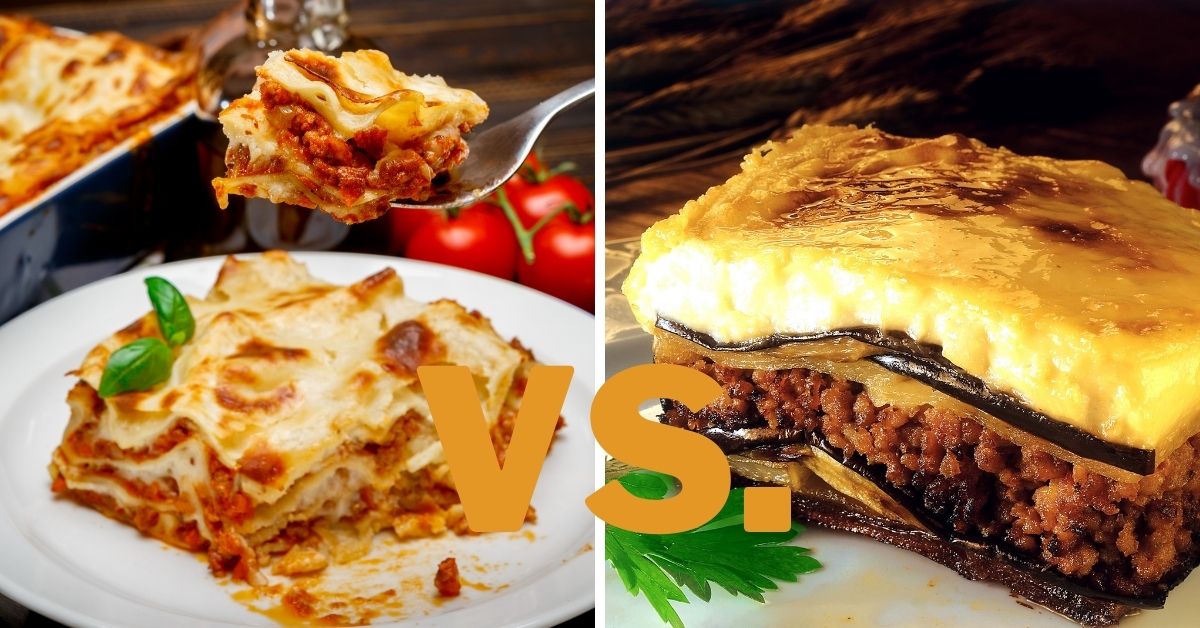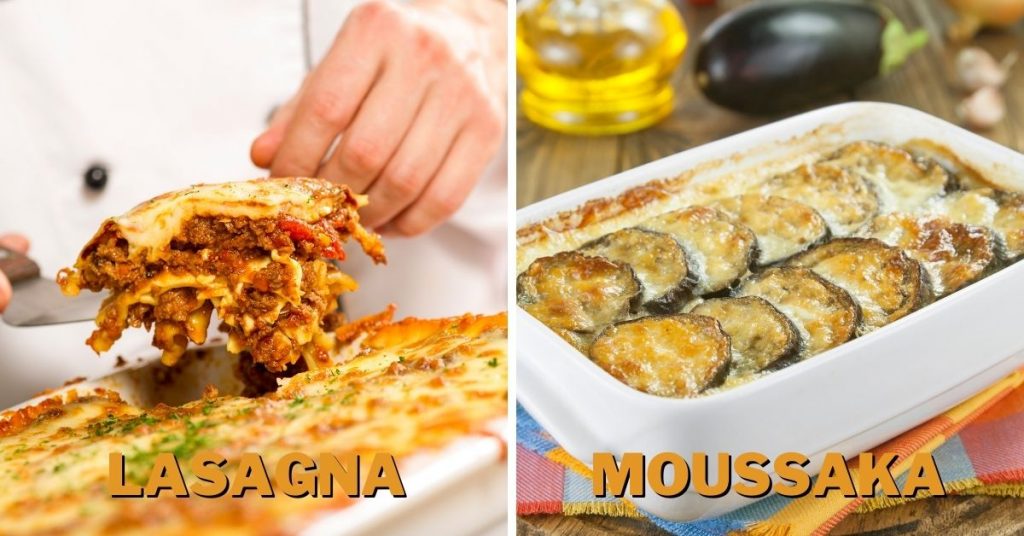Lasagna vs. Moussaka: Differences & Which Is Better?

On the surface, lasagna and moussaka share similarities as they have multiple layers and often include meat. But that is where the resemblance abruptly ends. So, how do lasagna and moussaka differ, and which is considered better?
Lasagna is a pasta dish originating in Italian cuisine, while moussaka is a potato or eggplant-based dish connected to Greek and Levantine cuisine. Lasagna includes tomato sauce, while moussaka is made with meat sauce without tomato. Moussaka includes eggs, while lasagna doesn’t. Also, moussaka is usually drier than lasagna.
Read on because I will share with you how their differences impact their tastes and which one is considered a better lunch idea.
Lasagna vs. Moussaka: Differences
Lasagna and moussaka come from vastly different parts of the world, with distinct methods of preparation and ingredients. So, let’s take a look at these distinctions in further detail and explore what makes each dish special.
Origin
Lasagna, like all pasta dishes, is deeply rooted in Italian cuisine. In fact, you can find evidence of lasagna even during the middle ages. Though the exact origin is unknown, historians believe the dish came from the city of Naples.
For the origin of moussaka, there are several theories. One is that you have to look to the Middle East, specifically the Levantine region. According to this theory, the ancestor to the current version of moussaka can be found in Levantine culture during the 15th century.
According to another theory, moussaka traces to Greek culture. This may be odd since we connect Greek cuisine with Mediterranean spices and light flavors.
The moussaka that we are all familiar with at present traces to the 19th century.
Appearance
The classic lasagna dish is one of the more iconic forms of pasta found all over the world. It is a multilayered dish where you add successive layers of sauce, pasta sheets or noodles, and cheese. Repeat this process as many times as you want to get yourself your desired number of layers.
On the other hand, moussaka has more variation in the ways that people serve it. Some moussaka dishes are layered just like lasagna. But other dishes are more akin to a pie. And even when they are layered, the number of layers is less than what you would find in a typical lasagna.

Ingredients
Any proper lasagna dish has a few things in common. They are a pasta-based dish. The specific type of pasta you use in this dish is even called “lasagna noodles” or “lasagna sheets”, which has a flat and rectangular shape. And on either side of that pasta, you add a layer of bechamel sauce, bolognese sauce and cheese.
The sauce, in most cases, includes meat in it. Most commonly used are ground beef or pork.
This is where moussaka really separates itself from lasagna. Instead of pasta sheets, moussaka uses potato or eggplants as its base. Moreover, to make moussaka, you just need to shortly sauté ground lamb or beef without adding tomato sauce. Bolognese sauce, on the other hand, can’t be made without tomato.
The meat you will find in moussaka is either lamb or beef.
When you are finished with layers, you should add bechamel sauce and cheese on the top of the lasagna. Contrary, a real traditional moussaka doesn’t incorporate bechamel sauce, but it is dressed with a mixture of eggs, milk and four. You can add cheese, but it’s not mandatory.
Here is the table that sums up the differences and similarities regarding ingredients in lasagna and moussaka.
| Ingredients | Lasagna | Moussaka |
|---|---|---|
| Pasta | + | – |
| Potato | – | + |
| Eggplant | – | + |
| Tomato sauce | + | – |
| Vegetables in sauce | + | – |
| Eggs | – | + |
| Milk | + | + |
| Cheese | + | – |
| Flour | + | + |
| Meat | + | + |
Sauce
This is another big point of distinction. Traditional lasagna is always made with bolognese sauce, which means that it always includes tomato sauce.
Another sauce you will normally find in a lasagna dish is called “béchamel”, which is a type of white sauce. And similar to any white sauce, it has a roux made of butter and flour as its base.
The meat for moussaka is quickly cooked separately and then added to the dish before the final bake. It doesn’t include onion, carrots, pepper, or any other vegetable you may find in bolognese sauce.
What brings moisture to moussaka is not bechamel, cheese or tomato, but a mixture of beaten eggs, milk and flour. Contrary to bechamel sauce, moussaka topping sauce doesn’t involve pre-cooking. You just mix the ingredients and pour them on potatoes or eggplant.
Preparation
Repetition is the key when making lasagna. First, you add a layer of sauce so that the dish does not stick to the pan. Then you cover the sauce with a layer of pasta sheet. Then you can add bechamel sauce, bolognese sauce and cheese. Repeat these steps as you desire or until you run out of sauce. Top it off with some cheese and bechamel and bake it in the oven.
The preparation of moussaka varies depending on the region. In Greek cuisine, you will find three layers. A bottom layer of eggplant, a middle layer of ground beef or lamb, and then a top layer of the egg mixture.
In Egypt, the eggplants are submerged in tomato sauce. In countries like Albania, Romania eggplant is replaced with potatoes and it may include ground pork instead of beef.

Serving
Serve lasagna while it’s warm, but not straight from the oven. If you try to cut it and take it from the pan too early, you risk the chance that it will be too watery.
You don’t need to wait that long for moussaka to set. It sets quickly after taking it out from the oven. Also, you can serve it warm as a main dish, or cold as an appetizer.
Popularity
Lasagna is a classic Italian dish that has become popular the world over. This is thanks to the thousands of Italians who have settled in many corners of the globe, bringing their culture and cuisine with them.
Although the origin of moussaka is most likely in the Middle East, it is the Greek version of the dish that has become popular in western countries. Variations of the dish are also popular in most of the Middle East, Egypt, and Turkey, as well southern parts of Europe.
Lasagna Vs. Moussaka: Which Is Better?
Lasagna and moussaka are two distinctly different dishes. For people who love tomato sauce, pasta, or cheese, lasagna is likely to be your choice.
But if you prefer a vegetable-based dish instead of pasta, moussaka is sure to win you over.
However, since lasagna incorporated more moist ingredients, moussaka is usually drier than lasagna, but also lighter.
What Came First: Lasagna or Moussaka?
You can trace the origin of lasagna all the way back to 14th century Italy, when the first instance of a dish resembling classic lasagna first appeared.
In contrast, although the specific origin of moussaka is more obscure, its inception does not go beyond the 19th century. In fact, the more popular version of the dish came to be in the early 19th century.
So, it is clear to see that lasagna far surpasses moussaka in terms of age. The Italians were enjoying lasagna centuries before the Levants or Greeks started to make moussaka.
To conclude, moussaka and lasagna are two culturally significant dishes that will deliver two different yet delightful experiences for your taste buds. So, the next time you are thinking of trying something new, give either of these dishes a try.
